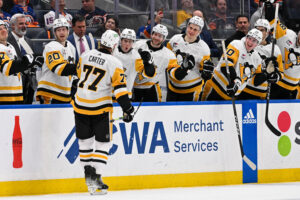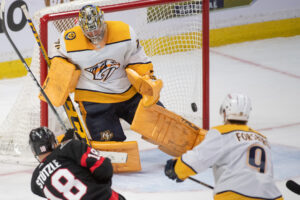In our third and final part of the series on San Jose Sharks general manager Doug Wilson, we examine the last few seasons and how the team and its executive leader have fared since its inflection point. In the first part, we covered his history, in the second part, how three critical decisions formed the basis for long-term success.
Early in his tenure with the Sharks, Wilson put together a trio that led to remarkable success. They’d been the core of one strong Sharks team after another. They’d done so for over a decade.
Then came the inflection point and the core was gone. By 2019, injuries had removed the elite game from Joe Thornton. The elite game of Joe Pavelski left town. And the elite game of Marc-Edouard Vlasic vanished into the ether.
Wilson thought he’d found a way to keep open the Sharks Stanley Cup window. Alas, his pursuit of John Tavares failed. But just two months later, he shocked the hockey world, finding a way to acquire yet another elite player, two-time Norris Trophy-winning defenceman Erik Karlsson.
Now it was up to the newer generation to pursue Stanley Cup for the next half-decade or so. It was in the hands of new captain Logan Couture with trade acquisitions Karlsson and Evander Kane. It hasn’t worked out.
Three Major Decisions
If the essential core of the Sharks was built on three major decisions, the undoing was also built on three major decisions. Two came on the same day, within hours of each other. Both Vlasic and goalie Martin Jones re-signed with the team, within hours of when they became eligible to sign an extension. Both on July 1, 2017. And both extensions wouldn’t go into effect for another season.
The third came with Erik Karlsson.
Decision 1: Martin Jones
It appeared the Sharks had found a cornerstone goalie in Jones. He had proven respectable in the regular season but elevated his game in the 2016 playoffs. It peaked in the Stanley Cup Final when Jones flat out stole Game 5 of the series.
For Sharks fans, this was new. The Sharks had respectable netminders over the years, but none had proven able to raise their game for the playoffs until Jones. So when the time came to renew Jones’ deal, few thought Wilson had made a drastic error.
Jones’ game simply fell off a cliff in the 2018-19 season and has been mostly absent since. He went from a close to a top-ten regular season netminder to among the league’s worst. Alas, he re-signed for a close to top-ten paycheck, and for six seasons in total. Still three to go after this one.
Decision 2: Marc-Edouard Vlasic
The second major mistake came with the Sharks re-signing Vlasic on the same day they re-signed Jones. Some considered Vlasic the league’s best defenceman. Few could shut down elite offensive players. Vlasic had proven he could do just that. In the 2016 Stanley Cup Final run, Vlasic shut down one elite player after another. It was tour de force. Vlasic was consistently among the Sharks’ best defensive players, and even more critically, he seemed to find another level come playoffs when the match-ups got even juicier.
Alas, Vlasic’s game, much like Jones, fell off a cliff. Before re-signing, Vlasic’s contract was among the league’s best. Just four years later, his deal is among the league’s worst. It has five more years to go.
Decision 3: Erik Karlsson
The third mistake is more of a two-step. First, Wilson acquired Erik Karlsson in September 2018. To get the two-time Norris winner, Wilson parted company with a chunk of the team’s middle class and a chunk of the future. The trade made sense for a team prepared to take a Stanley Cup shot. And it appeared to be working. After a slow start in 2018, Karlsson returned not merely to elite form but was perhaps the best player in the entire league. For six weeks, the Sharks were the league’s apex predator. The Tampa Bay Lightning hadn’t lost a game in over a month, but they were chum for the streaking Sharks. The vision Doug Wilson had was now in focus – this Sharks team was capable of beating everyone.
Then came Karlsson’s mid-season injury. And while the Sharks remained a good team, it was clear the difference between being a good team and an elite one was Karlsson playing at the top of his game.
The second step came when Doug Wilson signed Karlsson to an eight-year extension in the 2019 offseason. It made Karlsson the highest-paid defenceman in league history ($11.5 million cap hit). It was also a dicey call. In part because the Sharks were betting on a player with a bit of an injury history staying healthy. In part because of the compounding effects of the trade and re-signing. With the trades for Karlsson and (to a lesser extent) Kane, the team parted with a lot. Many young, talented and inexpensive players were traded away. It hit both the roster and the team’s AHL pipeline hard.
Wilson also parted with high draft picks, the sort which could replenish the pipeline. The trades for both Karlsson and Kane included escalator clauses, which meant the Sharks gave up higher picks if the players were re-signed. But wait, there’s more. The Karlsson contract on top of the Kane contract pushed the Sharks hard against the salary cap, leaving no room for the Sharks to retain a middle class. Joe Pavelski, Joonas Donskoi, Gustav Nyquist all left because the team had insufficient cap space. Traded players included Chris Tierney, Dylan DeMelo and a promising Joshua Norris. Several first and second-round draft picks were gone as well.
The Karlsson deal and re-signing created a Sharks payroll resembling a barbell. It was loaded with expensive talent on one side and budget talent on the other — and nothing in between. For a while, the team had no player contracts paying between $2million and $5million per year. Somewhat shocking given the average NHL deal is almost smack in the middle of that range.
The Decision Consequences
With Karlsson, the Sharks simply put too much into one player. He was always going to be hard-pressed to earn his deal. He’d not only need to be elite when he played, but he’d also need to be healthy and provide leadership. He’s done none of the three consistently. He’s often not been healthy and he’s rarely been a leader. At times, he’s played very well, but these times are a small fraction of the Sharks games since the signing.
Between Jones, Vlasic and Karlsson, the Sharks committed over $24million annually to three players who simply haven’t come close to earning their deals. It is one thing to have an underperforming deal. Or even two. But three, which combined for roughly 30% of the salary cap, that is simply too much.
While each contract could be justified at the time, none have worked out.
The New Formula Failure
The combination of never having early picks to access elite talent and trading away draft picks was always a potential problem. In recent seasons, potential became a reality.
Giving Doug Wilson his due, he did his Houdini best to maintain and reload for far more years than was reasonable. Few organizations can be Stanley Cup competitive without infusing high-end talent, and most of that comes at the top end of the draft. Other methods of acquiring such talent, via high-end free agency and trade, are more expensive.
For the first decade of Wilson’s tenure, he avoided signing players to long-term deals. This changed when he inked Brent Burns to an eight-year deal in 2016. In subsequent seasons, he’d sign Vlasic, Kane, Couture and Karlsson to deals of seven or eight years. Goalie Martin Jones got a six-season deal.
The Sharks are locked into deals that are hard to get out of. Vlasic and Karlsson have no-movement clauses, not that any team would take on the contract of either player. Couture, Kane and Burns have movement restrictions on their contracts, though none of the deals are problematic at the moment. And no one wants a goalie earning close to the top ten money who posts save percentages near the league bottom.
Wilson did leave himself a bit of wiggle room. It was reasonable to expect increased cap space in each subsequent season, enough to add a middle-tier player. Covid-19 and the flat cap crushed that.
A Way Out for Doug Wilson
Is there a way out for Wilson and the Sharks? I mean, other than owner Hasso Plattner showing Wilson the door? Which would be a way out for Wilson, but not the team.
There is… sort of. One thing is clear, the deals for the team’s high-end talent have not led to a competitive team. Both Vlasic and Karlsson have deals that rank among the league’s worst. The deal for Jones, a goalie who burned brightly and has appeared to burn out, is no better. Burns and Kane are both performing at a level in the vicinity of their respective deals, though the odds are they won’t get better from here. In short, the Sharks are in trouble, despite a respectable level of talent on the roster.
With the top paid talent underachieving and no recent elite-level draftees coming to help, the Sharks have a genuine rebuild in front of them. After all the seasons of success, the painful hangover has arrived. Made it more painful because it lacks a Stanley Cup.
Unwinding and Rebuilding
The Sharks need to unwind their big deals for ageing players. Burns’ deal ends when he is 40. Vlasic, 39. Couture 38. Karlsson, 36 (37 if the team makes it to the Cup Final). Kane 34. Jones 34. These are the team’s five highest-paid players, plus Jones, who is seventh. They combine for 58% of the league’s current salary cap.
They can afford to keep some of these players, but not all. This is a multi-year situation and denial can’t be part of the process.
The Sharks need to draft the sort of elite players who haven’t been available to Wilson for his entire Sharks tenure. Getting a top talent with a latter-round pick wouldn’t hurt. It is something Wilson has done before, but not recently. Getting another Pavelski or another Vlasic after round 1 would be a big help. Perhaps Wilson is due.
Doug Wilson and Alexander Hamilton
Throughout his tenure, Wilson has moved with urgency. In the play Hamilton, a question about Hamilton is frequently repeated: “why do you write like you’re running out of time?” For Wilson, substitute in the word ‘trade’ for ‘write’ and you’d be onto something. Wilson makes a lot of moves. In the recent lead-up to the trade deadline, Wilson made five different trades, none of which are likely to make much of a difference (the best acquisition being a fourth-round draft pick). In the most recent draft, he traded away every one of the team’s original seven picks.
Is Wilson running out of time in San Jose? Perhaps. He certainly trades like it. But assuming he remains, the Sharks need to have a plan. Wilson needs to have a plan. An honest plan.
An Approach for Doug Wilson
Trades, buyouts and the Seattle Kraken all have a role to play in the next phase. The team can unload at least one larger contract to the Kraken. Let the Kraken take one contract off the Sharks books. The 2021-22 Sharks are not going to suddenly become highly competitive. So wait for the buyout on Jones for another season. The longer the wait, the fewer the seasons the cap buyout will impact the organization. Similarly with Vlasic, especially given the longer term and bigger price tag. Plus, there is always a chance one of the players returns to form at least enough to trade.
As of now, a buyout of Jones would impact the Sharks salary cap for six years. Wait a year and the impact is four more years. With Vlasic, 10 years, all the way out to the 2030-31 season. Wait two seasons and at least the buyout impact ends in 2028-29.
Realistically, the Sharks can unload one major deal a year. In some cases, it may be a trade with retained salary. In other cases, a buyout. There will be windows with a player on LTIR or perhaps even an ‘earlier than expected’ retirement.
Three More Years
Come 2024-25, the Sharks can have the worst of this behind them and the best of times in front of them. But it takes three years and there is simply no good way to shortcut the process. Solid drafting the next few seasons with some premium picks can change a franchise in relatively short order. The model for this is the Colorado Avalanche. As recently as 2016-17, they were a last-place team. Just two seasons later, the Avs were a Cup contender; something likely to continue for many seasons to come.
Making the 2021 playoffs is possible, though not likely. At 46 games into the season, the team is on pace for 74 points in a normal 82 games season. Usually, the cut-off for a playoff team is around 95 points. The team’s record isn’t playoff worthy, though the oddities of 2021 may allow an also-ran into the tourney. Even if the Sharks mount a late-season surge, it’s not a prelude to greatness.
The Word Doug Wilson Refuses To Use
Wilson seems allergic to the word rebuild, he’s used other terms, including ‘reload’, ‘retool’ and just last month, ‘reset’. But whether he says it publicly or not, rebuild is what the Sharks require.
This was an issue I discussed prior to the start of the season, describing Wilson as having reached a fork in the road. I described his offseason moves as “hedged bets.”
What is the difference between reset and rebuild? In the 2020 offseason, Wilson traded draft picks for Devan Dubnyk and Ryan Donato. A reset plan.
I offered a different plan, one which retained both Joe Thornton and Aaron Dell, paid Taylor Hall (a free agent on a one-year deal) and traded away Kevin Labanc. How would this differ? The two Dubnyk trades (to and from San Jose) were a wash. A Labanc trade likely merited a second-round pick. Trading Hall at the trade deadline netted Buffalo a second-round pick, we’ll assume the same for the Sharks. Not trading for Donato would have saved the Sharks a third-round pick.
The net? Under my plan, the Sharks come out with two additional second-round draft picks and a third-round pick. Plus, nearly $5 million per season in cap space for the next few years. The team would be without Donato (a restricted free agent to be) and without Labanc.
For a team trying to rebuild, these three draft picks plus the substantial additional cap space met the organization’s needs more than Donato and Labanc. Wilson’s approach, lingering at the fork in the road, resulted in both an unrealized present opportunity and less future upside. The Sharks could be a year further into their rebuild, but they aren’t. Wilson hedged his bets, lingered at the fork in the road and ultimately, wasted an opportunity to accelerate the rebuild.
The R-Words
There is no path to greatness without a detour into a rebuild. Patience for a rebuild, however, is not an attribute Wilson has ever applied in his years as general manager. Can he adapt? More to the point, will Wilson be the leader to guide the franchise through this?
R-words, words like a rebuild, reset and retool have to have context in Sharks Territory. But another series of R-words serve as speculation on Wilson’s future in San Jose: removal, replacement, retirement and resignation.
Doug Wilson, age 63, has had a glorious run in San Jose. A Stanley Cup is the one thing that forgives all sins, and it has eluded him. Is Doug Wilson running out of time in San Jose? We’ll know the answer shortly after the season ends.
Main Photo:
Embed from Getty Images






